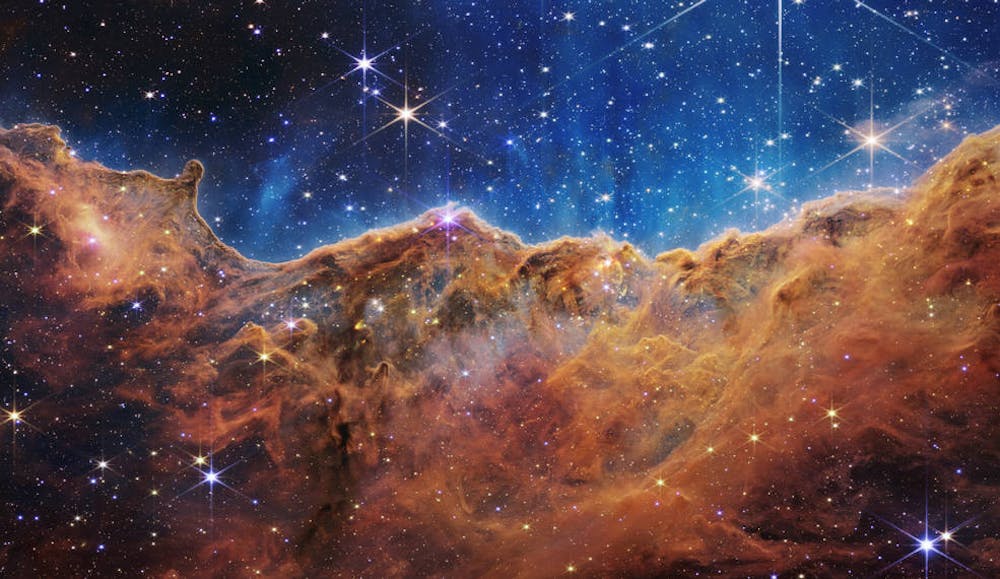After 26 years of work, the first image from the James Webb Space Telescope (JWST) was unveiled on July 11, unveiling a slice of the distant universe to the public. The following day brought three additional images, alongside an atmospheric spectrum of the exoplanet WASP-96 b, heralding Webb’s stellar arrival.
These early images drew global attention to the astronomers and engineers devoted to JWST and their mission of exploring the early universe, charting exoplanets and shining light onto astronomical mysteries.
While the public response has been positive, the excitement was palpable for members of the astronomical community.
Dan Coe, an astronomer at the Homewood-based Space Telescope Science Institute (STScI) who has been sharing his work from @CosmicSprngJWST on Twitter, described his first impressions of JWST data in an interview with The News-Letter.
“I got to see these images early, and then I was bursting with excitement for a few weeks to share them with everybody because you see some of these first images and you realize five things about the universe that you didn’t know before. It was emotional to finally see them coming out and other people reacting to them and seeing how amazing this data is,” Coe said.
Fellow STScI astronomer and JWST Science Policies Group Lead Christine Chen echoed Coe’s excitement, stressing the obvious improvement over the previous Hubble Space Telescope.
“What is really amazing about the early images is: one, you learn a lot more about dust in the universe, and two, you see further back in time — it's the second one which is getting a lot more attention right now because the gains that JWST is making is so amazing. JWST can do better than Hubble in terms of efficiency and detail; what used to take Hubble days, takes JWST hours,” she said.
The ramifications of this leap in efficiency and detail are already felt within the astronomical community with an influx of new data challenging long-standing conceptions and filling gaps in previous knowledge.
Chen, whose research interests include the formation and evolution of planetary systems, explains one example regarding the High Contrast Imaging of Exoplanets by a fellow researcher, Sasha Hinkley.
“It's been amazing to watch the community get adjusted to new data because people have never been able to take spectra like this before. There have been predictions for what atmospheres would be composed of, and the pressure-temperature profile of atmospheres,“ she said. “It’s amazing to watch in real-time how theory is confronted with data, forcing people to revise their understanding because it's not consistent.”
Brian Welch, a postdoctoral researcher at the NASA Goddard Space Flight Center and a recent Hopkins graduate noted that JWST has opened new windows into the early universe, using his discovery of the most distant star, Earendel, as a case study.
“We got our first round of images on the Earendel star, so I was taking that data and trying to figure out how much more we could learn from JWST data. With the Hubble data, we could identify that this was a star and that was about it; with the Webb images, we’ve been able to identify the color of the star which gives us a sense of what type of star we’re looking at and the temperature it might be,” he said.
Coe, Welch’s advisor, shares similar thoughts involving Webb’s role in his research into distant, gravitationally lensed galaxies, such as those found in Webb’s First Deep Field.
He discussed the personal significance of these findings to his research work.
“Everything I've been doing for the past 10 years has led up to this. I led a large galaxy survey with Hubble and the whole point of the survey was to discover distant galaxies that we could study in more detail with JWST,“ Coe said. “Now we’re doing it, and we're learning so much. We looked 97% of the way back to the Big Bang with Hubble and these galaxies appear like tiny blips, now with JWST we're able to actually see details, what they look like and what they're made of.”
Chen highlighted the excitement that has permeated beyond the scientific community as the JWST images were released, as seen in media coverage, musical tributes and TikTok commentaries.
“The public has really adopted JWST in the same way it adopted Hubble: as the People's Telescope… People can't get enough of it. At [STScI], we've always thought JWST is fantastic, but even we've been a little bit like ‘Wow, everyone's really excited,’” she said.
The long-term ramifications of JWST’s findings remain to be seen, but Welch is confident that it will inspire the next generation of astronomers and lead to countless discoveries in the years to come.
“Getting people excited stirs up interest in astronomy. The more people are interested, the more big projects like JWST can get funded and the more people will be interested in getting into astronomy. As far as setting ourselves up well for the future, these sorts of occasions where we have this great opportunity for public outreach are incredible,” he said. “I'm really looking forward to seeing how far we can push Webb's boundaries and all the amazing things it will show us.”





